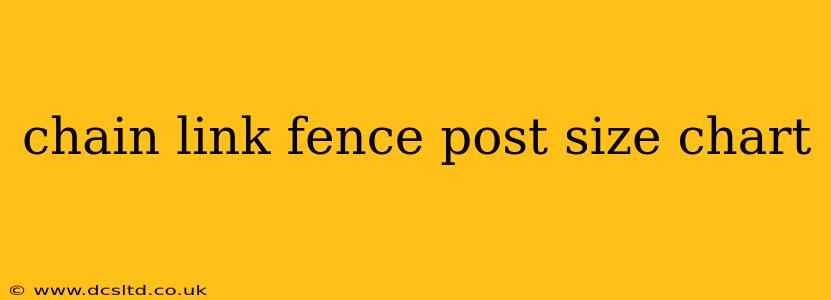Choosing the right chain link fence posts is crucial for a durable and long-lasting fence. This comprehensive guide provides a detailed chain link fence post size chart, along with explanations to help you select the appropriate posts for your project. Understanding post sizes ensures your fence withstands various weather conditions and provides years of reliable service.
What Factors Determine Chain Link Fence Post Size?
Several factors influence the size of chain link fence posts you'll need. These include:
- Fence Height: Taller fences require larger, stronger posts to support the weight and withstand wind pressure.
- Soil Conditions: Rocky or unstable soil needs more substantial posts for adequate anchoring.
- Wind Exposure: Areas prone to high winds necessitate larger posts to prevent damage.
- Fence Location: High-traffic areas or areas with potential impact require stronger, more robust posts.
Chain Link Fence Post Size Chart
The following chart provides a general guideline. Always consult local building codes and manufacturers' recommendations for specific requirements.
| Fence Height (ft) | Line Post Size (in) | End Post Size (in) | Corner Post Size (in) | Gate Post Size (in) |
|---|---|---|---|---|
| 3-4 | 1 5/8" | 2 3/8" | 2 3/8" | 2 3/8" |
| 4-5 | 2" | 2 3/8" | 2 3/8" | 2 3/8" |
| 5-6 | 2 3/8" | 2 3/8" | 2 3/8" | 3" |
| 6-8 | 2 3/8" | 3" | 3" | 3" |
| 8+ | 3" | 3" or larger | 3" or larger | 3" or larger |
Note: This chart represents typical sizes. Post diameter may vary slightly depending on the manufacturer. "Line Posts" are the standard posts used between corners and gates. "End Posts" are at the end of a fence run. "Corner Posts" support the change in direction. "Gate Posts" are used to support gates and require extra strength.
What are the Different Types of Chain Link Fence Posts?
Understanding the different types of posts is crucial for selecting the right ones for your fence project. They're typically classified by material and installation method:
- Steel Posts: The most common type, available galvanized or vinyl-coated for rust protection.
- Aluminum Posts: Lighter than steel, offering good corrosion resistance but less strength.
- Wood Posts: Less common for chain link, requiring frequent maintenance and susceptible to rot.
- Driven Posts: Driven directly into the ground using a post driver.
- Set-in-Concrete Posts: Set in concrete for maximum stability.
What Size Post Do I Need for a 6-Foot Fence?
For a 6-foot fence, the chart above suggests using 2 3/8" line posts, and 3" end, corner, and gate posts. However, remember to consider your specific needs, such as soil type and wind exposure, to determine the best size.
How Deep Should I Bury My Chain Link Fence Posts?
The depth of post embedment is crucial for stability. As a general rule, bury chain link fence posts at least one-third of their total height, but check your local building codes for specific requirements. For example, a 6-foot post should be buried at least 2 feet deep.
What are the Best Materials for Chain Link Fence Posts?
Galvanized steel posts are the most popular choice due to their durability, strength, and affordability. Vinyl-coated steel posts offer added rust protection and a more aesthetically pleasing appearance. Aluminum posts are a good option in coastal areas due to their excellent corrosion resistance.
This comprehensive guide provides a solid foundation for choosing the correct chain link fence post size for your project. Remember, always consult local building codes and manufacturers' recommendations for the best results. Proper post selection ensures a robust and long-lasting fence.
